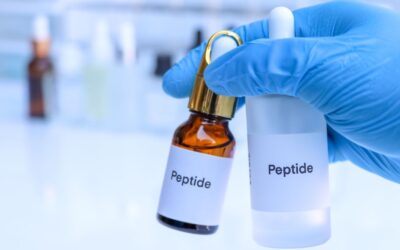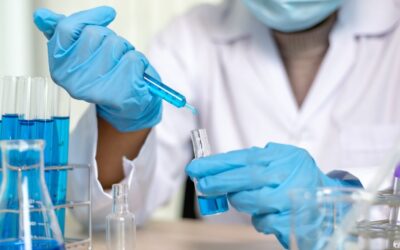Hyaluronic Acid in the Pharmaceutical Industry:
Manufacturing, Regulations and Finding the Right Supplier

Tânia Marante | Posted on September 12, 2024
- Introduction
- What is Hyaluronic Acid?
- Sodium Hyaluronate: A By-product of Hyaluronic Acid
- Production of Hyaluronic Acid: Innovations and Challenges
Introduction
You’ve probably heard about hyaluronic acid (HA) in numerous cosmetic commercials praising “miraculous effects” on the skin, especially over the past decade. We’ve all heard about it too.
The pharma cosmetics sector, which prominently features HA products, has grown substantially, becoming unsurprisingly a multi-billion-dollar industry. This expansion is driven by the increasing consumer demand for products that promise aesthetic enhancements and long-term health benefits.
As Hyaluronic Acid continues to be integral to formulations that target hydration and elasticity, its role in the pharma cosmetics market is only expected to increase and expand. This is because there is strong evidence that HA-based biomaterials offer therapies capable of tissue repair and skin regeneration (Nobile et al., 2014).
Although the biopolymer is a popular cosmetic ingredient, since its discovery in 1934, it’s also been a commonly known ingredient in the pharmaceutical industry mainly for its viscoelastic properties and natural presence in our bodies.
Hyaluronic acid occurs naturally in the body, and its primary characteristic is its unique ability to retain moisture and enhance viscosity, making it a sought-after ingredient in products aimed at hydration and lubrication.
From UTIs (Morales et al., 1996) to acid reflux (Advances In Clinical And Experimental Medicine, s. f.), dry eyes (Yang et al., 2021), and wound healing (Urman et al., 1991). The topic is heavily debated and researched due to the varying scientific support. Given its broad applications and increasing demand in medical treatments, gaining a solid understanding of its production processes, regulatory environment, and market dynamics is crucial for anyone in the pharma field, which brings us to this article.
Let’s dive deeper into this molecule. Its production, applications, regulations, choosing the best API supplier and more. But first things first.
What is Hyaluronic Acid?
Hyaluronic acid is a type of sugar called glycosaminoglycan, and it has exceptional water retention properties, making it ideal for medical applications involving skin hydration and tissue repair. Discovered by Karl Meyer in 1934, it has been extensively used in cosmetics but increasingly in pharmaceutical formulations due to its biocompatibility and natural degradation in the body. We’ll learn more about its production methods to understand how natural this agent is.
Sodium Hyaluronate: A By-product of Hyaluronic Acid
Sodium hyaluronate is the salt form of hyaluronic acid and is derived through the process of stabilizing hyaluronic acid. While the two are closely related, they are not identical in function. Sodium hyaluronate has a smaller molecular size, making it more stable and allowing it to penetrate deeper into the skin compared to hyaluronic acid, which tends to work on the surface.
Differences and Similarities
Both hyaluronic acid and sodium hyaluronate are recognized for their exceptional ability to retain moisture, making them key ingredients in skincare and pharmaceutical products. However, while hyaluronic acid hydrates the surface of the skin, sodium hyaluronate is more effective at delivering hydration (Snetkov et al., 2020) at a deeper level due to its smaller molecular structure. Despite these differences, they are often used simultaneously in products to maximize the moisturizing and anti-aging benefits. Including both ensures that different layers of the skin are targeted, enhancing the overall effectiveness of the formulation.
Applications of Sodium Hyaluronate
Like hyaluronic acid, sodium hyaluronate finds applications in various pharmaceutical and cosmetic products. Its ability to penetrate deeper into the skin makes it especially useful in anti-aging treatments, injectable fillers, eye drops for dry eyes, and topical wound healing products. In pharmaceutical formulations, it can also be found in joint injections for osteoarthritis treatments, where its properties help improve joint lubrication.

Production of Hyaluronic Acid: Innovations and Challenges
As we’ve seen in previous chapters, Hyaluronic Acid is naturally produced in the body, but which bodies? And how does it still influence today’s production methods? That’s what we’ll see in this chapter.
The active ingredient is produced via microbial fermentation but can also be derived from specific animal sources. Traditionally, Hyaluronic Acid was extracted from rooster combs, which are rich in this compound. However, extraction can also be done from other animal tissues, including bovine (cattle) and porcine (pig) sources. Studies like (Zhang et al., 2023) challenge the two main production methods of Hyaluronic Acid (HA) and its evolution to modern biotechnological methods. We’ll discuss the two main methods and their crucial factors in medical applications.
- Microbial Fermentation: This method uses bacteria like Streptococcus zooepidemicus, Corynebacterium glutamicum, and Bacillus subtilis to produce HA.The bacteria are grown in large batches, producing hyaluronic acid as part of their metabolic process. One challenge with this method is that the liquid culture becomes thick and difficult to manage due to the high viscosity of HA.Scientists add special enzymes to reduce viscosity and increase HA production to overcome this. This method is popular due to its scalability and ability to control the molecular weight and purity of the final product.
- Animal Tissue Extraction: Animal tissues, such as rooster combs, are becoming a less common method of extracting this molecule due to contamination and animal welfare concerns. Instead, microbial fermentation is now preferred because it is more sustainable and results in higher-purity HA.
Scaling up Production
Scaling up hyaluronic acid (HA) production poses challenges for manufacturers striving for effective, cost-efficient, and high-quality delivery of products.
Maintaining Sterility: The consequences of a single lapse in sterility can be fatal, potentially compromising an entire production batch. This emphasizes the importance of maintaining a sterile environment, especially in microbial fermentation processes. Advanced sterilization technologies and strict procedural controls to prevent contamination are definitely needed.
Ensuring Consistent Quality: Achieving consistent quality across different production batches is required. HA’s effectiveness in various applications depends on maintaining uniform viscoelastic properties, which requires precise control of fermentation conditions and the molecular weight distribution of the compound produced.
Optimizing Production Processes: To improve yield and reduce costs, manufacturers need to refine microbial strains, optimize fermentation processes to maximize output and enhance downstream processing for more effective extraction and purification of HA. This often requires significant investment in research and development.
Resource and Facility Requirements: Large-scale production demands high-quality raw materials, specialized equipment, and extensive facilities for biotechnological-sensitive output. This includes state-of-the-art bioreactors, precise filtration systems, and comprehensive quality control labs.
Skilled Personnel: Expertise in biotechnological processes and quality assurance is essential. Manufacturers need trained personnel to manage complex operations and ensure product consistency. Microbiologists, biochemical engineers, quality control, and production personnel are some of the experts you may need.
In the next chapter, we will discuss regulatory compliance, which is crucial for market entry and consumer safety.
Regulatory Landscape for Hyaluronic Acid
Understanding the regulatory landscape for HA is exploring the guidelines and requirements set by regulatory bodies worldwide across various markets. Let’s explore the guidelines and requirements of regulatory bodies in the United States, European Union, Japan, and other significant markets.
United States of America
In the United States, the Food and Drug Administration (FDA) oversees the regulation of Hyaluronic Acid products. Depending on their intended use—whether as medical devices, drugs, or cosmetics—the classification and approval process varies:
- Medical Devices: Products used in orthopedic injections or as dermal fillers with this compound are classified as medical devices and require pre-market approval (PMA) or 510(k) clearance to demonstrate safety and efficacy.
- Drugs: Formulations based on the hydrophilic polymer that claim therapeutic benefits, such as ophthalmic solutions or wound healing agents, must undergo the New Drug Application (NDA) process, which involves rigorous clinical trials.
- Cosmetics: Products containing this moisturizing agent for skin hydration and cosmetic purposes are less stringently regulated but must comply with safety requirements under the Federal Food, Drug, and Cosmetic Act.
For further details, please visit the FDA’s official website document on Hyaluronic Acid regulation, which provides advanced guidance and regulatory pathways for any of the molecule-containing products.
European Union
The European Medicines Agency (EMA) regulates Hyaluronic Acid products within the EU, with a focus on ensuring high standards of quality and safety:
- Medical Devices Directive (MDD): Products used as part of medical devices fall under the MDD, which requires conformity assessment and CE marking.
- Pharmaceuticals: Products claiming medical benefits are treated as pharmaceuticals and must meet the stringent clinical evaluation and pharmacovigilance requirements outlined in the EU’s centralized authorization procedure.
The EMA’s website has relevant regulatory documents and guidelines (ema.europa.eu).
Japan
In Japan, the Pharmaceuticals and Medical Devices Agency (PMDA) is responsible for regulating hyaluronate based products:
- Pharmaceuticals and Medical Devices Law: Products, depending on their use, may be classified either as pharmaceuticals or quasi-drugs, each requiring appropriate approval. For example, an injectable joint lubrication agent for arthritic treatment requires pharmaceutical approval with extensive safety and efficacy data.
- Regenerative Medicine: Used in regenerative medicine practices, it also faces strict scrutiny under Japan’s regenerative medicine regulations.
Visit the PMDA website here to consult on detailed resources and all regulatory updates related to HA.
Other Significant Markets
- China: The National Medical Products Administration (NMPA) regulates products, with recent updates focusing on streamlining approvals for innovative medical products.
- Canada: Health Canada oversees hyaluronate products under the Food and Drugs Act, categorizing them as drugs or medical devices based on their intended use.
- Brazil: The National Health Surveillance Agency (ANVISA) requires hyaluronate products, especially those used in medical treatments, to undergo registration and approval before market entry.

Make Smarter API Decisions with Data
Access exclusive insights on global API pricing, export/import transactions, competitor activities and market intelligence.
Applications of Hyaluronic Acid in the Pharmaceutical Industry
Hyaluronic Acid has carved out a significant niche in both medical and cosmetic fields for its remarkable versatility in various therapeutic applications, as we’ve seen so far. The compound is so multifaceted that it’s advancing treatment options across several disciplines, enhancing patient care. Let’s delve into the diverse uses of this molecule that underscore its critical role in contemporary healthcare solutions.
- Ophthalmic Solutions: The hydrophilic quality makes it exceptional for moisture-retention properties, a staple in treatments for dry eyes. It helps form a protective barrier that lubricates the eye without impairing vision, offering relief for dry eye symptoms in a manner that mimics natural tears.
- Injectable Dermal Fillers: Our polymer is one of the most popular choices in cosmetic dermatology and is known for its hydrating and volume-enhancing properties. It helps smooth wrinkles and add volume by binding water molecules in the skin, providing temporary but natural-looking results.
- Osteoarthritis Treatments: As a joint lubrication agent, hyaluronate injections can be a game-changer for joint disorders, particularly osteoarthritis. By supplementing the viscous properties of synovial fluid, these injections help lubricate and cushion joints, reducing pain and increasing mobility.
- Wound Healing: Hyaluronic Acid is effective in cosmetic procedures and critical in medical wound care. It accelerates the healing process by regulating inflammation and organizing the extracellular matrix, making it an excellent component in advanced wound dressings and post-surgical care.
Besides its main applications, Hyaluronic Acid is also found in:
- Drug Delivery Systems: Acting as a biocompatible carrier for targeted drug delivery, especially useful in cancer therapy.
- Tissue Engineering: Where it’s used as a scaffold material to support cell growth in regenerative medicine.
- Postoperative Adhesion Prevention: Applied during surgeries to prevent the formation of adhesions between tissues and organs.
- Vesicoureteral Reflux Management: Combined with dextranomer for treating vesicoureteral reflux in children.
- Dental Surgery: Aids in the healing of gum tissues and enhances the success of dental implants.
- Aesthetic Procedures: Used for lip augmentation and improving skin contour.
As research continues to unveil new uses and formulations of HA, its role in the pharmaceutical industry is poised to expand, ushering in an era of innovation and improved patient care.
Market Trends and Future Potential
The market for hyaluronic acid is projected to expand significantly.
According to a report by Grand View Research, the global hyaluronic acid market size was valued at USD 10.04 billion in 2023 and is projected to grow at a compound annual growth rate (CAGR) of 7.7% from 2024 to 2030.
MarketsandMarkets forecasts that the hyaluronate market will reach USD 2.6 billion by 2030, driven by increased applications in orthopedic and cosmetic procedures.
A publication in the Journal of Controlled Release discusses the potential of hyaluronate in drug delivery systems, highlighting its increasing adoption in sustained-release applications.
Disclaimer: Market projections for hyaluronic acid vary due to differences in analytic approaches, market definitions, geographic focus, and data sources among research firms. Readers are advised to consider these factors when evaluating market forecasts and to use a range of projections to inform their understanding and decision-making processes.
As for the areas where hyaluronate is set for significant growth there are plenty. Especially driven by its integration into advanced healthcare applications. Future trends include advanced delivery systems, regenerative medicine, and combination therapies.
Choosing a Hyaluronic Acid Supplier
Choosing a suitable hyaluronic acid (HA) supplier is crucial for any pharmaceutical or cosmetic business looking to incorporate the compound into its products. The selection process involves evaluating various factors to ensure the sourced API meets stringent quality, regulatory, and supply chain requirements. Here’s a more simplified list of what to consider when selecting a supplier:
Regulatory Compliance: The backbone of any successful partnership is trust, and this is particularly true when it comes to selecting a hyaluronic acid supplier. Your fundamental requirement is to ensure that a supplier adheres to global standards such as GMP, FDA, and any other international or regional standards that ensure the API is produced safely and meets all health regulations.
What’s important to note is that compliance is more than a box you check. It’s the only thing that instills a sense of security and confidence in your choice of supplier.
Material Quality: As we stated before, not all HA is created equal. Depending on its application, the compound must have a specific molecular weight and level of purity to ensure its effectiveness in medical, cosmetic, or other uses. Look for suppliers who provide your business with detailed documentation on the molecular characteristics of their Hyaluronic Acid and can meet the exact specifications required for your intended application.
Traceability and Documentation: In the pharmaceutical and cosmetic industries, the ability to trace the raw materials to their source is critical for quality assurance. Reliable suppliers should be able to provide comprehensive documentation, including certificates of analysis, material safety data sheets, and batch consistency reports, ensuring transparency throughout the supply chain.
Supply Reliability: Beyond quality, consistent ingredient availability is critical to uninterrupted production cycles. It’s important to assess a supplier’s ability to meet your volume requirements and deliver within agreed-upon timelines. Consider a supplier’s history of reliability in fulfilling large-scale orders and their capacity to scale production if needed.
Sustainability and Ethical Practices: Businesses increasingly prioritize sustainability in their supply chains. Sourcing it through environmentally friendly and ethical means, such as microbial fermentation rather than animal extraction, is a key consideration for these buyers. Suppliers that commit to reducing their environmental impact and supporting sustainable production methods may align better with long-term business goals.
Pricing and Cost-Effectiveness: While price shouldn’t be the sole deciding factor, it’s essential to evaluate the overall cost of sourcing HA, considering both the price per unit and the costs associated with quality assurance, logistics, and long-term reliability. Competitive pricing, paired with high-quality standards, ensures a supplier can offer the best value for your business.
Pharmaoffer and other B2B platforms offer a marketplace to connect buyers with reputable Hyaluronic Acid suppliers who meet these rigorous standards. However, the final decision should always be based on an in-depth evaluation of each supplier’s ability to deliver quality and compliance.
You made it to the end! We hope you found this article helpful and enjoyed our journey into Hyaluronic Acid. This is undeniably a key player in the pharmaceutical and cosmetic industries, and it’s safe to say that it’s not going anywhere soon.
Understanding the complexities of its production, requirements, and supply chain as its demand grows is essential for businesses aiming to leverage HA’s potential. That is why staying informed about market trends and regulations is crucial to selecting suitable suppliers. Position your company to capitalize on HA’s expanding role in modern healthcare and discover the right supplier with Pharamoffer.
Follow this and other ingredients that make your business run by clicking the follow button and be on top of your API game.
References
Nobile, V., Buonocore, D., Michelotti, A., & Marzatico, F. (2014b). Anti‐aging and filling efficacy of six types hyaluronic acid based dermo‐cosmetic treatment: double blind, randomized clinical trial of efficacy and safety. Journal Of Cosmetic Dermatology, 13(4), 277-287. https://doi.org/10.1111/jocd.12120
Shang, L., Li, M., Xu, A., & Zhuo, F. (2024). Recent applications and molecular mechanisms of hyaluronic acid in skin aging and wound healing. Medicine In Novel Technology And Devices, 23, 100320. https://doi.org/10.1016/j.medntd.2024.100320
Morales A, Emerson L, Nickel JC, Lundie M. Intravesical Hyaluronic Acid in the Treatment of Refractory Interstitial Cystitis. Journal of Urology [Internet]. 1996 Jul 1 [cited 2024 Sep 4];156(1):45–8. Available from: https://doi.org/10.1016/S0022-5347(01)65933-0
Advances in Clinical and Experimental Medicine. (s. f.-b). https://advances.umw.edu.pl/en/ahead-of-print/171001/
Yang, Y., Lee, W., Kim, Y., & Hong, Y. (2021). A Meta-Analysis of the Efficacy of Hyaluronic Acid Eye Drops for the Treatment of Dry Eye Syndrome. International Journal Of Environmental Research And Public Health, 18(5), 2383. https://doi.org/10.3390/ijerph18052383
Urman, B., Gomel, V., & Jetha, N. (1991). Effect of hyaluronic acid on postoperative intraperitoneal adhesion formation in the rat model. Fertility And Sterility, 56(3), 563-567. https://doi.org/10.1016/s0015-0282(16)54558-0
Zhang, Y., Dong, J., Xu, G., Han, R., Zhou, J., & Ni, Y. (2023). Efficient production of hyaluronic acid by Streptococcus zooepidemicus using two-stage semi-continuous fermentation. Bioresource Technology, 377, 128896. https://doi.org/10.1016/j.biortech.2023.128896
Snetkov, P., Zakharova, K., Morozkina, S., Olekhnovich, R., & Uspenskaya, M. (2020). Hyaluronic acid: the influence of molecular weight on structural, physical, Physico-Chemical, and degradable properties of biopolymer. Polymers, 12(8), 1800. https://doi.org/10.3390/polym12081800
What is Hyaluronic Acid, and why is it important in the pharmaceutical industry?
Hyaluronic Acid (HA) is a naturally occurring glycosaminoglycan known for its exceptional water retention properties, making it essential for hydration and tissue repair. In the pharmaceutical industry, HA is used in a wide range of applications, including ophthalmic solutions, wound healing products, and osteoarthritis treatments. Its biocompatibility and ability to enhance viscosity make it a key ingredient in both medical and cosmetic formulations.
How is Hyaluronic Acid produced for pharmaceutical use?
Hyaluronic Acid is typically produced using microbial fermentation or through animal tissue extraction. Microbial fermentation, involving bacteria like Streptococcus zooepidemicus or Bacillus subtilis, is the most common method today due to its sustainability, scalability, and ability to produce high-purity HA. Animal tissue extraction, such as from rooster combs, is less commonly used due to contamination risks and animal welfare concerns.
What are the key regulations for Hyaluronic Acid in the pharmaceutical industry?
In the pharmaceutical industry, Hyaluronic Acid is regulated differently depending on the product’s use. In the U.S., the FDA classifies HA-based products as either medical devices, drugs, or cosmetics, each requiring different levels of approval. The European Medicines Agency (EMA) and Japan’s PMDA have similar guidelines, with a focus on clinical safety and efficacy for medical applications. Understanding these regulatory pathways is essential for bringing HA products to market.
What is the difference between Hyaluronic Acid and Sodium Hyaluronate?
Hyaluronic Acid and Sodium Hyaluronate are closely related but differ in molecular size and function. Sodium Hyaluronate is the salt form of HA, with a smaller molecular structure, allowing it to penetrate deeper into the skin. While both are used for hydration and tissue repair, Sodium Hyaluronate is more stable and effective for deeper skin penetration, making it ideal for injectable fillers and deeper-level moisturization.
How do I choose a reliable Hyaluronic Acid supplier?
When choosing a Hyaluronic Acid supplier, it’s important to consider factors like regulatory compliance (GMP, FDA), product quality, traceability, and supply reliability. Suppliers should provide documentation on HA’s molecular characteristics and meet your specific application needs. Additionally, evaluating their commitment to sustainability, especially in sourcing HA through microbial fermentation rather than animal extraction, can align with long-term business goals.






Check out all other blogs here!